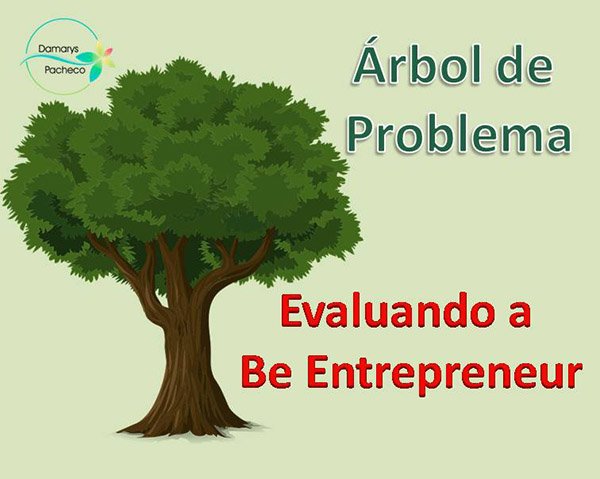
Ármate de valor y analiza el problema
¿Alguna vez has tenido un problema que temes mirar con atención? Me imagino que sí, porque como emprendedores se nos presentan con cierta constancia diversas situaciones que crean conflictos y que normalmente las resolvemos sin mayores contratiempos para seguir avanzando, sin embargo, dentro de estas puede haber situaciones más complejas que no son de forma sino de fondo que requieren que le prestemos especial atención.
Y es allí donde la fuerza y el valor flaquean. Sabemos que el emprendimiento está trastabillando, dando tumbos, pero no hacemos un alto para analizar lo que sucede, posiblemente, porque intuimos las razones, afloran los temores o sencillamente consideramos que no tenemos las herramientas para afrontarlo, es aquí donde probablemente pase por nuestra mente la posibilidad de desistir, abandonar el barco y echar la mirada hacia otro puerto con mayores posibilidades.
Entonces te cruza como una ráfaga la famosa frase de Neil Armstrong, "Insistir, persistir, resistir y nunca desistir" y comienzas a cuestionarte: ¿He hecho todo lo que puedo?; ¿Está en mis manos la solución del problema?; ¿Vale la pena el esfuerzo que requiere? Y quizás la más importante ¿Qué puedo hacer? Si bien es cierto que la frase citada es muy motivadora, no menos cierto es que nadie quiere darse golpes contra la pared insistiendo y persistiendo en algo que no da resultados positivos.
Siguiendo este hilo de idea surge otra pregunta: ¿Insistir, persistir, resistir, en qué? Haciendo algo distinto para poder tener resultados distintos, ¿Positivos, negativos? Pues realmente no lo sabremos con certeza hasta que actuemos, lo que si puede ayudar a marcar la diferencia es que se hace necesario analizar el problema de fondo para poder conocer las alternativas y a partir de allí establecer las nuevas estrategias.
Existen varias herramientas que nos ayudan a realizar este análisis lógico de un problema: entre ellos: la matriz de Vester, el análisis de pareto, el árbol de problemas, entre otros. Hoy quiero hablarte de este último, el árbol de problema, una herramienta que nos permite captar la situación problema, determinar si hay más de un problema, proceder a caracterizarlos y jerarquizarlos para establecer los objetivos con los cuales nos montamos en un plan de acción para desarrollarlo en un tiempo determinado, tras el cual, evaluaremos el éxito del mismo.
Realizar este trabajo tiene sus ventajas:
1.- Nos permite visualizar de manera desglosada al mismo tiempo que global el problema que tenemos. Es decir, de un solo vistazo podemos darnos una idea general de la situación, sus causas y efectos.
2.- Podemos relacionar con mayor facilidad las causas y efectos que nos lleva a comprender con mayor amplitud y profundidad la complejidad del problema.
3.- Este análisis se convierte en insumo para darle continuidad al trabajo, identificando posibles soluciones y crear el Árbol de Objetivos.
El árbol sirve como metáfora de los pasos a dar:
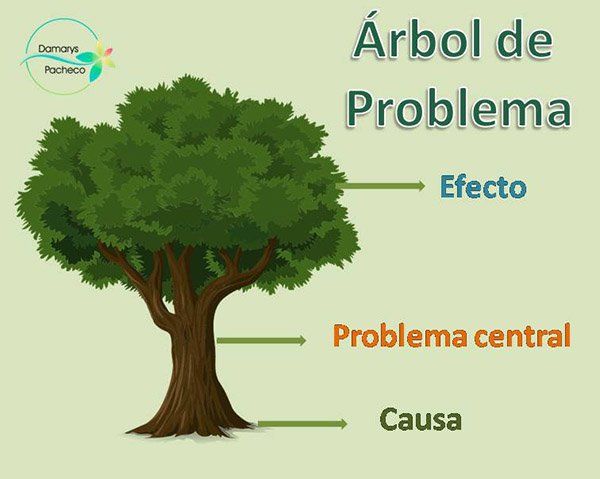
Como observamos en la figura el tronco representa el problema central, acá es oportuno acotar que podemos tener más de un problema, en ese caso lo más conveniente es trabajar cada uno por separado y luego trabajar con un diagrama que recoja todas las ideas. Las raíces son las diversas causas que generan el problema y las hojas los efectos negativos que dicho problema trae al emprendimiento.
Ilustremos con un ejemplo muy concreto la aplicación de esta herramienta en un emprendimiento. Armándonos de valor, tomemos el caso de la comunidad Be Entrepreneur.
Contextualizando tenemos una comunidad con ocho meses de fundada que nace con el objetivo puntual de ser un espacio educativo para desarrollarnos como emprendedores, donde cada uno de los miembros contribuirá con su contenido de calidad, experiencia y conocimiento formal al crecimiento de los demás.
A lo largo de estos ocho meses la dinámica de la comunidad ha sido fluctuante, así encontramos que ha habido semanas, que según el histórico ha tenido alto movimiento y semanas de muy bajo movimiento.
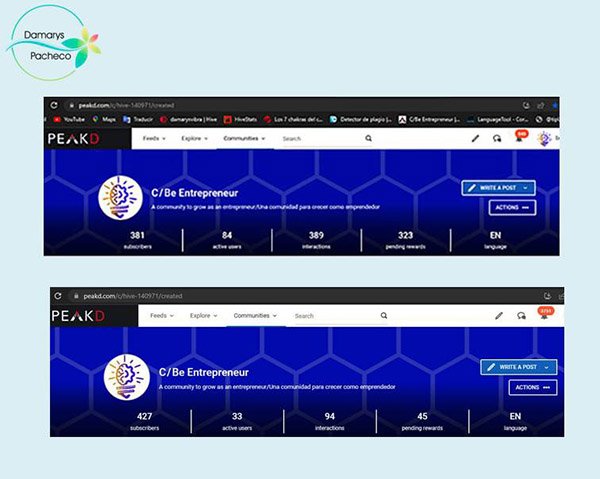
La primera imagen corresponde al 19 de febrero del año en curso y la segunda al día de hoy. En ellas podemos evidenciar los cambios:
*Aun cuando hay más suscriptores, las publicaciones en la comunidad han bajado drásticamente, así como la interacción entre los miembros y ni que decir de las recompensas pendientes.
*No hay que darle muchas vueltas al asunto para detectar el problema que tenemos: La baja participación de los miembros para publicar contenido de valor con constancia.
Una vez detectado el problema pasemos al desarrollar el Árbol.
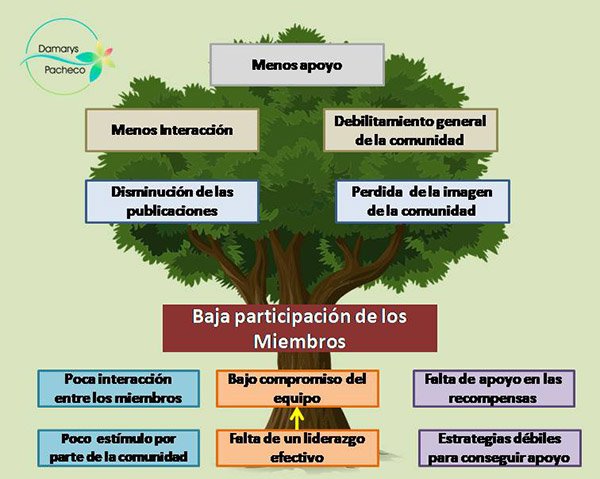
Comentemos la forma de leer el esquema: comencemos de abajo para arriba, entendiendo que la de abajo es un nivel más profundo o derivado de la de arriba, interpretando que el bajo compromiso del equipo de la comunidad se debe a la falta de un liderazgo más efectivo o que las estrategias para conseguir apoyo de curadores fuertes se debe a la misma falta de liderazgo.
En cuanto a los efectos que el poco estímulo que la comunidad brinda a sus miembros hace que cada día disminuyan las publicaciones, que haya menos interacción entre los creadores de contenido y por ende hay menos apoyo, lo cual debilita la imagen de la comunidad y consecuentemente tenemos menos apoyo, el clásico ejemplo de girar sobre el mismo círculo, el perro mordiéndose la cola.
Ahora bien, esta es una apreciación muy personal que requiere de miradas distintas tanto internas como externamente, por lo cual te invito a ser parte de esta evaluación, de esta lluvia de ideas que busca detectar los problemas de la comunidad, sus causas y los efectos que trae, para posteriormente, trabajar en las posibles soluciones.
Espero tu evaluación en la caja de comentarios o si lo prefieres escribe un post en la comunidad dándonos tu visión del asunto, te estaremos agradecidos.

In English
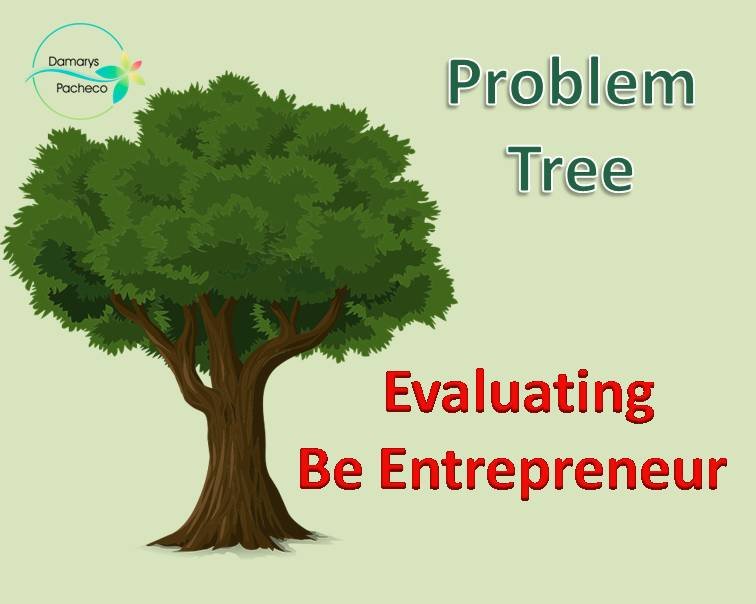
Take courage and analyze the problem
Have you ever had a problem that you are afraid to look at closely? I imagine you have, because as entrepreneurs we are constantly presented with different situations that create conflicts and we usually solve them without major setbacks to keep moving forward, however, within these there may be more complex situations that are not of form but of substance that require us to pay special attention.
And it is there where strength and courage falter. We know that the venture is stumbling, stumbling, but we do not stop to analyze what is happening, possibly because we sense the reasons, fears arise or we simply consider that we do not have the tools to deal with it, it is here that probably crosses our mind the possibility of giving up, abandoning the ship and look towards another port with greater possibilities.
Then Neil Armstrong's famous phrase, "Insist, persist, resist and never give up" crosses your mind and you begin to question yourself: Have I done everything I can; Is the solution to the problem in my hands; Is it worth the effort it requires? And perhaps most importantly, what can I do? While it is true that the above phrase is very motivating, it is no less true that no one wants to hit the wall insisting and persisting on something that does not give positive results.
Following this train of thought, another question arises: Insist, persist, resist, in what? Doing something different in order to have different results, positive, negative? Well, we will not really know for sure until we act, what can help to make a difference is that it is necessary to analyze the underlying problem in order to know the alternatives and from there establish new strategies.
There are several tools that help us to perform this logical analysis of a problem: among them: the Vester matrix, the pareto analysis, the problem tree, among others. Today I want to talk to you about the latter, the problem tree, a tool that allows us to capture the problem situation, determine if there is more than one problem, characterize and prioritize them to establish the objectives with which we set up an action plan to develop it in a given time, after which we will evaluate its success.
Doing this work has its advantages:
1.- It allows us to visualize in a disaggregated way at the same time that global the problem we have. That is to say, at a glance we can get a general idea of the situation, its causes and effects.
2.- We can more easily relate the causes and effects that leads us to understand the complexity of the problem with greater breadth and depth.
3.- This analysis becomes an input to give continuity to the work, identifying possible solutions and creating the Objective Tree.
The tree serves as a metaphor for the steps to be taken:
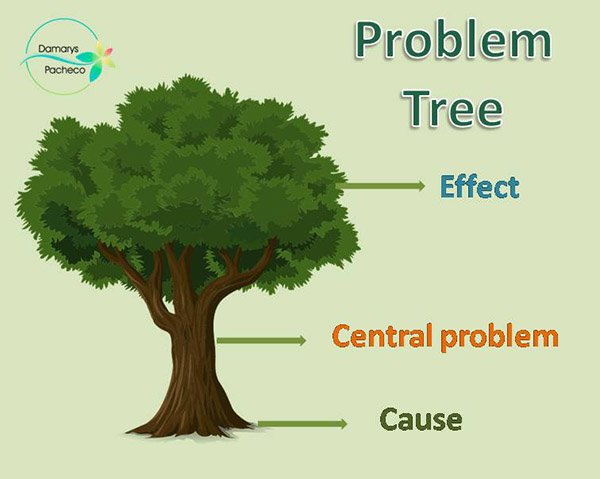
As we observe in the figure the trunk represents the central problem, here it is appropriate to note that we can have more than one problem, in that case the most convenient is to work each one separately and then work with a diagram that collects all the ideas. The roots are the various causes that generate the problem and the leaves are the negative effects that the problem brings to the venture.
Let's illustrate with a very concrete example the application of this tool in a venture. Let's take the case of the Be Entrepreneur community.
Contextualizing, we have an eight-month-old community that was created with the specific objective of being an educational space to develop as entrepreneurs, where each member will contribute with their quality content, experience and formal knowledge to the growth of others.
Throughout these eight months the dynamics of the community has been fluctuating, so we found that there have been weeks, which according to the history has had high movement and weeks of very low movement.

The first image corresponds to February 19 of this year and the second to today. In them we can see the changes:
*Even though there are more subscribers, the publications in the community have dropped drastically, as well as the interaction between members and not to mention the pending rewards.
*It doesn't take a lot of thinking to detect the problem we have: The low participation of members to publish content of value with constancy.
Once we have detected the problem, let's move on to the development of the Tree.
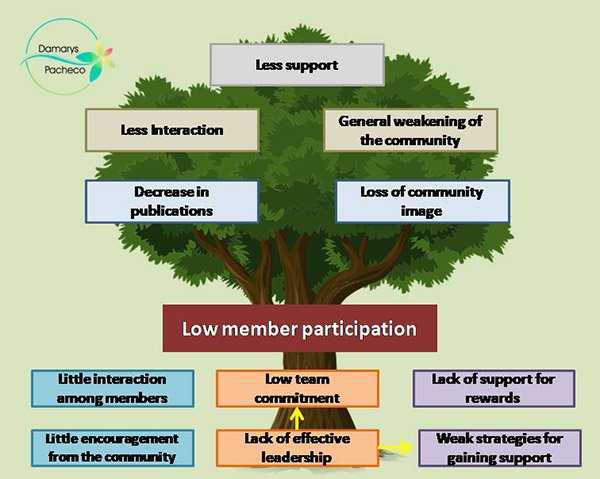
Let's comment on how to read the scheme: let's start from the bottom up, understanding that the bottom one is a deeper level or derived from the top one, interpreting that the low engagement of the community team is due to the lack of a more effective leadership or that the strategies to get support from strong curators is due to the same lack of leadership.
As for the effects that the little encouragement that the community provides to its members makes that every day publications decrease, that there is less interaction between content creators and therefore there is less support, which weakens the image of the community and consequently we have less support, the classic example of spinning on the same circle, the dog biting its tail.
Now, this is a very personal assessment that requires different views both internally and externally, so I invite you to be part of this evaluation, this brainstorming that seeks to detect the problems of the community, its causes and the effects it brings, and then work on possible solutions.
I look forward to your evaluation in the comments box or if you prefer write a post in the community giving us your vision of the matter, we will be grateful.

Translated with www.DeepL.com/Translator (free version)
Fuente de imagen: Imagen de OpenClipart-Vectors en Pixabay. Modificado en PowerPoint



MIS REDES SOCIALES





Be Entrepreneur



The rewards earned on this comment will go directly to the people( @garybilbao ) sharing the post on Twitter as long as they are registered with @poshtoken. Sign up at https://hiveposh.com.
Saludos, mi estimada Damarys. Tenía un post pendiente para esta comunidad y ya lo programé (a las 2:00 p.m. sale del horno). Trata sobre vender y de cómo podemos ayudar a otros a través de nuestro producto o servicio.
Muy bueno el "Árbol de los problemas", no conocía esta técnica. La tendré en cuenta. Y ya que lo aplicas con la comunidad Be Entrepreneur, aprovecho mi visita para dejar mi opinión.
Tal vez no sea el más indicado, ya que mi actividad en Hive no es muy constante, sin embargo, me atrevo a decir que una solución para lo que está pasando es propiciar más iniciativas, tener columnistas fijos (no sé si los hay) y hacer una especie de reto semanal a través de clases o talleres o posts tipo lecciones con ejercicios. Otra opción es invitar por Twitter a los hivers para que se unan a la comunidad y escriban su post de presentación y den a conocer su emprendimiento. Algo que se me viene a la mente es como una especie de foro, donde un emprendedor exponga sus dudas o problemas con su emprendimiento (tal como lo estás haciendo tú) y los usuarios comenten sus opiniones para ayudar a ese emprendedor.
En fin, son solo ideas, espero puedan ser útiles para resolver un poco la situación.
Un abrazo.
Hola amigo @gsbilbao gracias por tomate el tiempo para dar tan buenas sugerencias, las tomaré en cuenta para el próximo post que dándole continuidad a este va referido a las propuestas a través de objetivos muy concretos. Gracias, gracias 😊.
Con respecto a las iniciativas, hoy o mañana saco un post desde la comunidad uniéndonos a una iniciativa que nos invitaron a participar, espero que te unas ... Está pendiente 😍
Tu post ya llegó, voy para allá. Saludos y gracias por ser parte de Be Entrepreneur. Te invito a crear una columna ¿Te animas? 🤓
seleccionar todas las formas de problemas que se encuentran en una empresa nos ayudará a resolverlos de una en una. En las empresas, enfrentamos diferentes desafíos que deben corregirse antes de que derrumbe nuestro negocio.
As entrepreneurs, it is important to take courage and analyze the problem. We cannot simply give up when things are tough. We must have the courage to face the problem and find a solution. God Bless You @damarysvibra